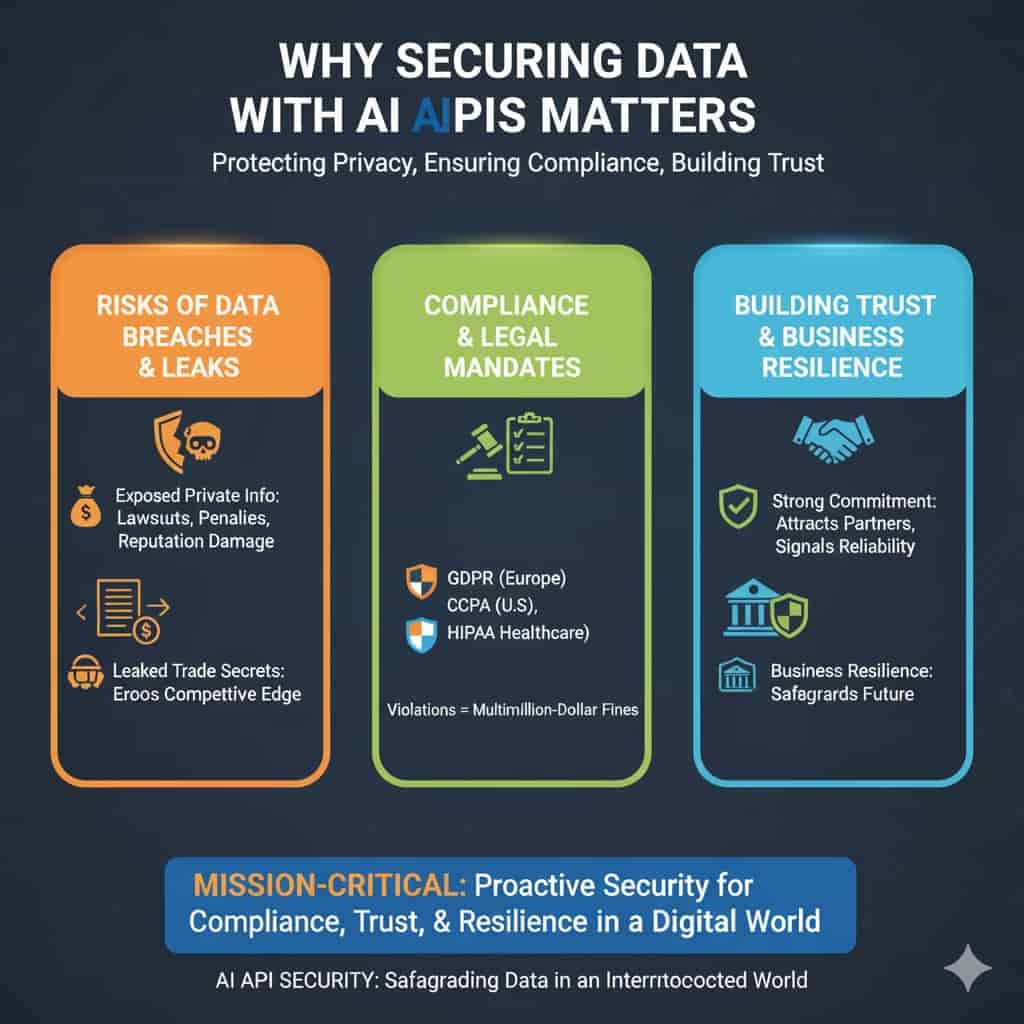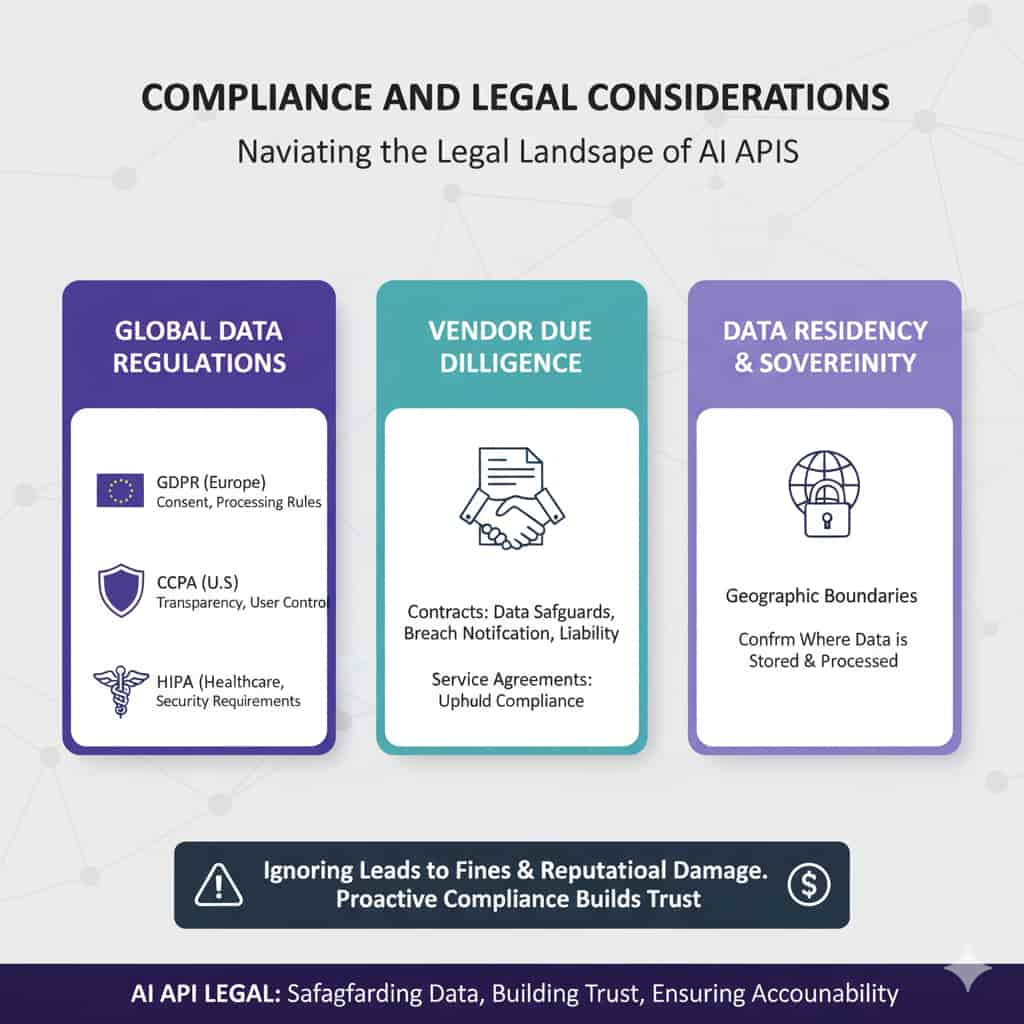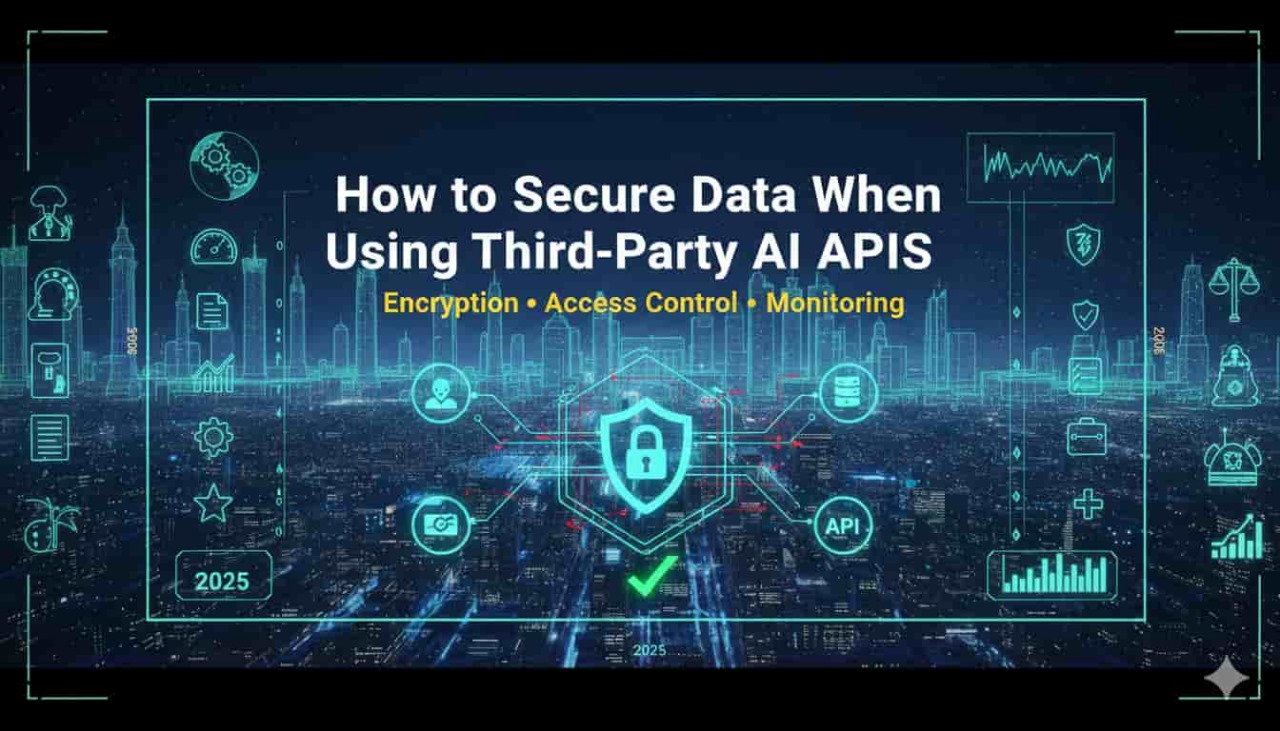Third Party AI APIs
Businesses frequently use third-party AI APIs to improve their applications in the rapidly evolving digital landscape of today. These tools increase efficiency and creativity, but they also put sensitive data at risk. Long-term success and trust depend on knowing how to secure data when integrating with outside Party AI services.
What Are Third-Party AI APIs?
In essence, a third-party AI API is a ready-made service that enables businesses to access Party AI capabilities without having to create their own models. Developers can use features like natural language processing, computer vision, speech recognition, and predictive analytics right away by connecting to an API rather than training enormous datasets internally.
Specialized vendors who have made significant investments in building and hosting sophisticated Party AI systems are responsible for creating and maintaining these APIs. They are used by businesses in a variety of sectors, including healthcare, finance, and retail, to improve user experiences, automate procedures, and streamline workflows. For instance, a retail business may incorporate an API to assess customer sentiment in real-time reviews, while a financial application may use it to identify fraudulent transactions.
Convenience and scalability are what make it appealing. Advanced Party AI-powered services can be swiftly implemented by businesses without major upfront expenses or technical challenges. An app can “think” or “see” in ways that would otherwise take years to develop internally with just a few lines of code.
But there are costs associated with this convenience. There is a chance of exposure each time data moves through a third-party system. Organizations must balance the advantages of using these tools against the need to protect their data, whether it be sensitive financial records, customer information, or intellectual property. The first step in creating a solid security strategy is comprehending what these APIs are and why businesses use them.
Why Securing Data with AI APIs Matters
When sensitive data travels through third-party AI APIs, the stakes are high. Data breaches and leaks can devastate businesses by exposing private information, leading to costly lawsuits, financial penalties, and irreparable damage to brand reputation. For instance, leaked customer details can fuel identity theft, while exposed trade secrets can erode a competitive edge.
Compliance is another critical factor. Laws such as the General Data Protection Regulation (GDPR) in Europe, the California Consumer Privacy Act (CCPA) in the United States, and the Health Insurance Portability and Accountability Act (HIPAA) in healthcare require organizations to manage personal data responsibly. Violating these laws doesn’t just hurt customers—it can result in multimillion-dollar fines.
Trust is also influenced by security. Confidence is the foundation of successful business relationships. Partners or clients might be reluctant to work with you if they worry that your systems could compromise their data. On the other hand, demonstrating a strong dedication to data security can work to your advantage by demonstrating dependability and professionalism.
Think about data passing through a chatbot driven by Party AI that responds to delicate client inquiries. Without protections, bad actors could record, intercept, or even resell conversations. In a similar vein, healthcare apps that use AI for diagnosis must guarantee patient data privacy and HIPAA compliance.
In summary, it is imperative to protect data when utilizing third-party AI APIs; it is not an optional practice. In an increasingly linked digital world, a proactive approach guarantees business resilience, protects compliance, and fosters trust.

Key Risks When Using Third-Party AI APIs
4.1 Data Exposure During Transmission
Whenever information is sent from your systems to a third-party API, it rig ole through networks where military operation may endeavor to intercept it. Without encryption, sensitive details can be exposed like postcards sent without envelopes.
4.2 Insecure API Endpoints
An API endpoint acts like a digital doorway. If left unlocked or poorly restrained, hackers can walk right in. Weak authentication, outdated communication theory protocol, or unpatched vulnerabilities make these endpoints prime targets for cybercriminals.
4.3 Misconfigured Access Permissions
Not all users or use need full access to API functions. Overly broad permissions are like giving every employee the master key to your office building. Misconfigurations can expose critical data to unintended parties.
4.4 Lack of Visibility and Monitoring
Many business organization “set and forget” API integrations, assuming the vendor handles everything. Without every day monitoring, suspicious activity may go unnoticed. Operation thrive in these blind spots, quietly exploiting weaknesses.
4.5 Vendor Security Vulnerabilities
Even if your internal systems are air-tight, your vendor’s security posture matters just as much. A single overlooked vulnerability on their end can become an open backdoor to your aggregation. High-profile breaches have shown how weak vendor controls ripple across entire industries.
Best Practices to Secure Data
5.1 Use Encryption for Data in Transit and at Rest
Encryption transforms clear data into coded text, making it useless to anyone without the key. Er use TLS/SSL for transmission and strong encryption standards like AES-256 for storage.
5.2 Implement Strong Authentication and Authorization
Use multi-factor marking (MFA) and role-based access controls (RBAC). This secure that only the right people or systems can access sensitive data.
5.3 Minimize Data Sharing with Principle of Least Privilege
Only share the minimal required data with APIs. Think of it as packing lightly for a trip—the less you bring, the less you can lose.
5.4 Regularly Audit and Monitor API Activity
Set up logging, monitoring, and anomalousness detection. Regular audits help identify unusual activity, unauthorized access, or performance issues before they escalate.
5.5 Secure API Keys and Credentials Management
API important are like digital legal document. Store them in secure vaults, rotate them regularly, and never hard-code them into applications.
5.6 Use API Gateways and Firewalls
Gateways act as checkpoints that enforce security policies, limit traffic, and device out malicious requests. Combined with firewalls, they form a robust protective layer.
5.7 Implement Data Anonymization or Masking
When working with erogenous data, anonymize or mask identifiers like names, addresses, and social security department numbers. This reduces risk if the data is exposed.
By layering these practices together, organizations create a defense-in-depth strategy—similar to locking doors, installing cameras, and hiring guards all at once.
Compliance and Legal Considerations
Complying with international data protection laws is crucial. GDPR requires stringent processing guidelines and consent. Transparency and user control over personal data are mandated by the CCPA. Healthcare information is governed by HIPAA, which has strict privacy and security regulations.
Due diligence on vendors is equally crucial. Contracts should specify liability, contain provisions for breach notification, and specify who is responsible for protecting data. The vendor’s adherence to your compliance requirements must be guaranteed by service agreements.
Issues of data sovereignty and residency are also important. Certain laws mandate that data remain inside predetermined geographic bounds. Verify where your data will be processed and stored before choosing a vendor.
Neglecting these legal aspects may result in significant penalties and harm to one’s reputation. Conversely, proactive compliance shows accountability and fosters customer trust.

How to Evaluate Third-Party AI API Providers
7.1 Security Certifications and Compliance Audits
Look for vendors with certifications like ISO/IEC 27001 or SOC 2. Regular audits demonstrate ongoing allegiance to security standards.
7.2 Transparency in Data Handling Policies
Marketer should clearly explain how they collect, store, and use data. Equivocal policies are a red flag.
7.3 Service-Level Agreements (SLAs) for Security
An SLA should include warrantee around uptime, breach notification timelines, and data handling protocols. These cooperation hold vendors accountable.
7.4 Vendor Track Record and Trustworthiness
Analyze past breaches, certificate incidents, or customer reviews. A vendor’s history often reflects their future reliable ness.
Selecting the right supplier is like choosing a business organization partner—you want someone dependable, transparent, and committed to your mutual success.
Tools and Frameworks for Securing Party AI API Data
Several tools and theoretical account can alter your defense:
- API Security Testing Tools like Postman, OWASP ZAP, or Burp Suite help identify vulnerabilities.
- Data Loss Prevention (DLP) Solutions prevent sensitive information from leaving your systems unchecked.
- Secure DevOps (Dev Sec Ops) Practices integrate security into every stage of development, ensuring APIs remain safe as they evolve.
- Cloud Security Frameworks such as NIST Cybersecurity Framework and ISO/IEC 27001 provide structured guidelines for risk management.
By combine these solutions, business organization can proactively assured AI integrations instead of reacting to terror after the fact.
Read more: How to Prevent API Security Risks Caused by AI Agents
Future Trends in AI API Security
The security of AI APIs is changing quickly. AI-driven threat detection is growing in popularity, employing machine learning to identify anomalous trends and possible security breaches instantly.
Additionally, zero-trust architectures are becoming more popular. Zero-trust necessitates constant user, device, and system verification rather than assuming trust within a network. This reduces the possibility of unwanted access when used with APIs.
Federated learning, which enables AI models to learn from dispersed data without transferring it to a central location, is another new trend. This method lessens the need to give outside providers access to sensitive raw data.
These developments hold out hope for a time when data security and AI capabilities can coexist more easily, easing the conflict between security and innovation.
Read more: Securing APIs in the Age of AI: New Risks and Threat Models …
Conclusion
Although third-party AI APIs present significant data security challenges, they also present exciting opportunities for innovation. Businesses can achieve the ideal balance between utilizing AI and protecting sensitive data by identifying important risks, implementing layered best practices, and selecting reliable vendors. Long-term resilience is ensured by adherence to international regulations, proactive monitoring, and strategies that are prepared for the future. Data security is an ongoing commitment that changes with technology rather than a one-time event. The people who give it top priority now will be in the best position to prosper in the AI-driven world of tomorrow.
Read more: AI Ethics Regulation in Pakistan and India Best of 2025
Frequently Asked Questions
1. What types of data should never be shared with third-party AI APIs?
Highly sensitive data such as passwords, financial account details, medical records, and trade secrets should never be shared unless absolutely necessary and secured with strong safeguards.
2. How can businesses ensure API providers comply with GDPR or HIPAA?
Request compliance certifications, review audit reports, and include legal clauses in contracts that bind providers to these standards.
3. What’s the difference between encryption and anonymization in securing API data?
Encryption scrambles data so only authorized parties can read it, while anonymization removes identifiers to prevent data from being linked to individuals.
4. How often should businesses audit their third-party AI integrations?
At least annually, though quarterly reviews are recommended for industries handling highly sensitive data.
5. Are on-premise AI models more secure than third-party APIs?
On-premise models offer more control but also require significant resources to maintain. Security depends on implementation and vigilance.
6. What’s the role of API gateways in data security?
They act as checkpoints, enforcing authentication, filtering traffic, and blocking malicious requests before they reach the API.
7. How can companies protect API keys from theft or misuse?
Store them in secure vaults, rotate regularly, and never expose them in public code repositories.
8. What are the red flags when evaluating a third-party AI API vendor?
Lack of transparency, no certifications, vague policies, or a history of breaches.
9. Can zero-trust security be applied to AI APIs?
Yes. By verifying every request and user continuously, zero-trust reduces the attack surface and strengthens security.
10. How do small businesses secure data without large security budgets?
Adopt affordable tools like cloud-native security services, implement encryption, and enforce strict access controls. Even basic steps can significantly reduce risk.


1 thought on “Secure Data Using Third Party AI APIs 2025”